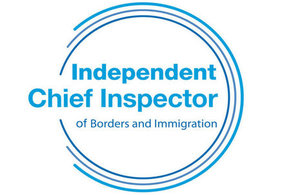An inspection of asylum casework, March to July 2015
The Independent Chief Inspector has released his inspection of asylum casework for the period, March to July 2015.

ICIBI logo
Since 2008, the inspectorate has conducted 8 inspections into various aspects of the Home Office’s asylum work. This latest inspection examined the department’s asylum casework operations and the quality of decision-making. The inspection looked at the registration, screening and routing process; how substantive asylum interviews were conducted and whether material facts were captured and probed; and whether decision-making was in accordance with Home Office guidance.
The inspection was conducted between March and July of 2015, just ahead of the sharp increase in Asylum applications in the second half of 2015.
The inspection found that the Home Office had made significant improvements in the efficiency and effectiveness of its management of asylum casework during 2014 to 15. It had met its aim of deciding all straightforward claims made on or after 1 April 2014 within 6 months, while successfully clearing all straightforward claims lodged before 1 April 2014 by 31 March 2015. The inspection also found that non-straightforward cases were being monitored effectively and decided quickly once barriers had been removed.
The inspection found that decision-makers, and other staff within Asylum Operations (AO), were professional, dedicated, and demonstrated a commitment to fairness. However, the quality of interviewing and decision-making needed to improve, along with the recording of the reasons for decisions.
As the report shows (Figure13), between August 2014 and August 2015 there was a 50% rise in asylum applications. Senior managers told us that they were aware that performance against service standards could be at risk from the rising intake and future budget pressures. They confirmed that contingency plans were in place to deal this.
The inspection identified a number of areas for improvement, including aspects of the screening process. It found that management of further leave applications from unaccompanied asylum-seeking children could be improved to reduce delays and to maintain contact with the claimant. However, the most serious failings concerned the way in which allegations of torture were managed. Neither the Immigration Rule 35 process nor the Medico-Legal report process was working as intended.
This report makes 9 recommendations for improvement and the Home Office has accepted 5 of these and partially accepted the remaining 4. The recommendations are below:
-
Identify from the Quality Analysis Team’s work why the screening process was falling short of ‘satisfactory’ and use the learning to ensure that guidance, training and supervision of interviewers is fit for purpose. * The Home Office accepted this recommendation.
-
Replace the internal target for screening interview timeliness with a published service standard, and monitor performance against those service standards to reduce risk to overall efficiency and effectiveness. * The Home Office partially accepted this recommendation.
-
Improve the routine capture and analysis of data and management information in respect of asylum cases managed by the Third Country Unit (TCU) in order to understand why Formal Requests (FR) to other States to accept responsibility are unsuccessful and why removals by the TCU fail, and take the necessary steps to reduce both. * The Home Office accepted this recommendation.
- Review the arrangements for handling claims of torture, in particular:
* identify the reasons why Rule 35 submissions fail, and why failed Rule 35 submissions subsequently succeed under the medico-legal route, and feed back to those involved in producing and reviewing Rule 35 submissions; and
* explore how to accelerate the medico-legal route for asylum claimants, in the meantime adjusting the Asylum Policy Instruction reference to a 5-month process to match the reality.
- The Home Office partially accepted this recommendation.
-
Extend the ‘second pair of eyes’ process for asylum claims based on membership of a particular social group (PSG) in order to improve the quality of decision-making in all complex and sensitive cases. * The Home Office partially accepted this recommendation.
-
While remaining on top of ‘straightforward’ asylum claims so that they meet the 6-month service standard from lodging the claim to providing the claimant with a decision, explore ways to reduce the number of ‘non-straightforward’ cases that are more than 12 months old. * The Home Office accepted this recommendation.
-
Ensure that decision-makers follow Home Office guidance when considering applications for settlement from individuals who have been granted Discretionary Leave as an Unaccompanied Asylum-seeking Child (UASC), and that they record this in sufficient detail. * The Home Office accepted this recommendation.
-
Publish service standards for extension of leave and settlement applications in UASC cases, and ensure that the further leave process is managed to provide timely decisions and to maintain appropriate contact with applicants (or their guardian or social worker) pending the decision. * The Home Office partially accepted this recommendation.
- Review roles, responsibilities (including oversight) and resources in relation to the administration of paper files for asylum claimants in order to reduce the number of misfiled documents and to ensure that claimants’ original documents are stored securely. * The Home Office accepted this recommendation.
The report was sent to the Home Secretary on 9 December 2015.